Number 718 - Jimi Hendrix
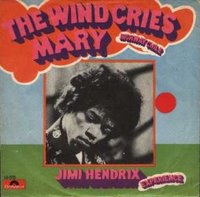
Number 718
Jimi Hendrix
"Wind Cries Mary"
(1967)
Jimi Hendrix
"Wind Cries Mary"
(1967)
Genre:Rock
 I make it no secret that i think Jimi Hendrix is a wee bit overated. Maybe he was a pioneer in his genre, sure. (Why do i get the feeling im going to end up in Guantanamo Bay?) But was Jimi Hendrix the worlds greatest guitarist? Hell no. This is where the "Jimi Purists" will say if it wasn't for Hendrix there would have been no Prince, Vaughan or Satriani, and i say, "i dont think so Tim", they would've existed regardless.
I make it no secret that i think Jimi Hendrix is a wee bit overated. Maybe he was a pioneer in his genre, sure. (Why do i get the feeling im going to end up in Guantanamo Bay?) But was Jimi Hendrix the worlds greatest guitarist? Hell no. This is where the "Jimi Purists" will say if it wasn't for Hendrix there would have been no Prince, Vaughan or Satriani, and i say, "i dont think so Tim", they would've existed regardless. 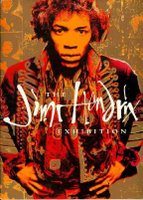 PERHAPS no other rock-and-roll trailblazer was as original or as influential in such a short span of time as Jimi Hendrix. Widely acknowledged as one of the most daring and inventive virtuosos in rock history, Hendrix pioneered the electric guitar (he played a right-handed Fender Stratocaster — his "Electric Lady" — upside-down and left-handed) as an electronic sound source capable of feedback, distortion, and a host of other effects that could be crafted into an articulate and fluid emotional vocabulary. And though he was on the scene as a solo artist for less than five years, Hendrix is credited for having a profound effect on everyone from George Clinton and Miles Davis to guitarists Stevie Ray Vaughan and Vernon Reid.
PERHAPS no other rock-and-roll trailblazer was as original or as influential in such a short span of time as Jimi Hendrix. Widely acknowledged as one of the most daring and inventive virtuosos in rock history, Hendrix pioneered the electric guitar (he played a right-handed Fender Stratocaster — his "Electric Lady" — upside-down and left-handed) as an electronic sound source capable of feedback, distortion, and a host of other effects that could be crafted into an articulate and fluid emotional vocabulary. And though he was on the scene as a solo artist for less than five years, Hendrix is credited for having a profound effect on everyone from George Clinton and Miles Davis to guitarists Stevie Ray Vaughan and Vernon Reid. 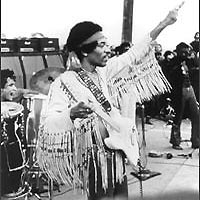 Born Johnny Allen Hendrix on November 27, 1942, Hendrix's father, James "Al" Hendrix, later changed his son's name to James Marshall. Young Jimi taught himself to play the guitar during his schoolboy days in Seattle, drawing influence from blues legends like B.B. King and Robert Johnson. He slung his guitar over his back and left home to enlist in the 101st Division of the Air Force (the "Screaming Eagles"), where he served as a parachute jumper until an injury led to his discharge. Hendrix then began working as a session guitarist under the name Jimmy James, playing behind such marquee acts as Sam Cooke, Ike and Tina Turner, and the Isley Brothers. After gigging extensively with Little Richard in 1964, Hendrix became entangled in a contract dispute with the mercurial artist and left to form his own band, Jimmy James and the Blue Flames. With the exception of an obscure single, "My Diary," with Rosa Lee Parks, none of the music Hendrix cut with other artists was made more remarkable by his presence.
Born Johnny Allen Hendrix on November 27, 1942, Hendrix's father, James "Al" Hendrix, later changed his son's name to James Marshall. Young Jimi taught himself to play the guitar during his schoolboy days in Seattle, drawing influence from blues legends like B.B. King and Robert Johnson. He slung his guitar over his back and left home to enlist in the 101st Division of the Air Force (the "Screaming Eagles"), where he served as a parachute jumper until an injury led to his discharge. Hendrix then began working as a session guitarist under the name Jimmy James, playing behind such marquee acts as Sam Cooke, Ike and Tina Turner, and the Isley Brothers. After gigging extensively with Little Richard in 1964, Hendrix became entangled in a contract dispute with the mercurial artist and left to form his own band, Jimmy James and the Blue Flames. With the exception of an obscure single, "My Diary," with Rosa Lee Parks, none of the music Hendrix cut with other artists was made more remarkable by his presence.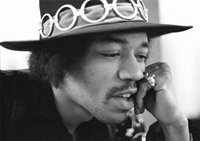 Hendrix's first single, "Hey Joe," a cover of a song written by the L.A. band the Leaves, hit the U.K. charts in early 1967, followed in quick succession by "Purple Haze," "The Wind Cries Mary," and the trio's ferocious debut album, Are You Experienced?, which featured those tracks and the Hendrix staples "Foxy Lady" and "Manic Depression." Hendrix's popularity Stateside was a bit slower in igniting, but Are You Experienced? finally broke through in a major way after a defining moment at the famed Monterey Pop Festival when the notoriously outlandish frontman created a sensation by coaxing flames from his Strat during the band's performance. The next year, Hendrix's eclectic psychedelia reached a zenith with two albums, Axis: Bold As Love and Electric Ladyland — the latter ranks as one of the greatest works of the rock era. But the experience at the top didn't last long — Hendrix and bassist Redding grew apart, and muddled by overindulgence in drugs and groupies, Hendrix came to believe — wrongly — that his management was cheating him. In 1969, the Experience disbanded.
Hendrix's first single, "Hey Joe," a cover of a song written by the L.A. band the Leaves, hit the U.K. charts in early 1967, followed in quick succession by "Purple Haze," "The Wind Cries Mary," and the trio's ferocious debut album, Are You Experienced?, which featured those tracks and the Hendrix staples "Foxy Lady" and "Manic Depression." Hendrix's popularity Stateside was a bit slower in igniting, but Are You Experienced? finally broke through in a major way after a defining moment at the famed Monterey Pop Festival when the notoriously outlandish frontman created a sensation by coaxing flames from his Strat during the band's performance. The next year, Hendrix's eclectic psychedelia reached a zenith with two albums, Axis: Bold As Love and Electric Ladyland — the latter ranks as one of the greatest works of the rock era. But the experience at the top didn't last long — Hendrix and bassist Redding grew apart, and muddled by overindulgence in drugs and groupies, Hendrix came to believe — wrongly — that his management was cheating him. In 1969, the Experience disbanded.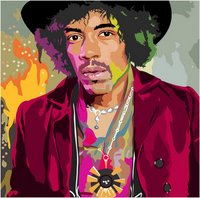 In the summer of 1969, Hendrix played Woodstock with an informal ensemble called the Electric Sky Church, in a performance highlighted by another career-defining moment: a startling, renegade rendition of "The Star-Spangled Banner." Hendrix subsequently formed the Band of Gypsys, with old Air Force friend Billy Cox on bass and Buddy Miles (Electric Flag) on drums. The band's New Year's Eve concert at the Fillmore East in New York City provided them with material for their first album, Band of Gypsys (more material from the show was released on Band of Gypsys 2 in 1986). Hendrix brought Mitch Mitchell back into the fold in mid-1970 to begin work on a new double album Jimi had tentatively titled First Rays of the New Rising Sun. Several tracks were recorded for the project, but the sessions were sandwiched between tour dates, and, sadly, the album was left unfinished when Hendrix died September 18, 1970. The cause of death noted on the coroner's report was inhalation of vomit after barbiturate intoxication. In 1993, the investigation into Hendrix's death was reopened by Scotland Yard, but when no new evidence was unearthed, the matter was dropped.
In the summer of 1969, Hendrix played Woodstock with an informal ensemble called the Electric Sky Church, in a performance highlighted by another career-defining moment: a startling, renegade rendition of "The Star-Spangled Banner." Hendrix subsequently formed the Band of Gypsys, with old Air Force friend Billy Cox on bass and Buddy Miles (Electric Flag) on drums. The band's New Year's Eve concert at the Fillmore East in New York City provided them with material for their first album, Band of Gypsys (more material from the show was released on Band of Gypsys 2 in 1986). Hendrix brought Mitch Mitchell back into the fold in mid-1970 to begin work on a new double album Jimi had tentatively titled First Rays of the New Rising Sun. Several tracks were recorded for the project, but the sessions were sandwiched between tour dates, and, sadly, the album was left unfinished when Hendrix died September 18, 1970. The cause of death noted on the coroner's report was inhalation of vomit after barbiturate intoxication. In 1993, the investigation into Hendrix's death was reopened by Scotland Yard, but when no new evidence was unearthed, the matter was dropped.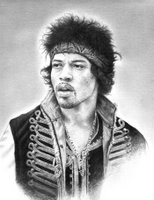 In 1971, several of the tracks intended for First Rays were compiled and released as The Cry of Love, and the ensuing years have witnessed a flood of releases of Hendrix tributes, books, videos, and albums, including pre-fame barrel-scrapings of Hendrix takes from his pickup guitarist days. Posthumous releases took on new life in the CD era. In 1994, MCA released three Hendrix thematic compilations: one devoted to blues songs recorded between 1966 and 1970 (Jimi Hendrix: Blues), one to his live performance at Woodstock (Jimi Hendrix: Woodstock), and a third (Voodoo Soup) that represented an attempt to recreate Hendrix's unfinished fourth studio album. In April of 1997, yet another attempt was made to recreate the album Hendrix was working on at the time of his death, but this time the project was overseen by Hendrix co-producer Eddie Kramer and historian John McDermott — and it had the Hendrix family stamp of approval. The seventeen-track album, First Rays of the New Rising Sun, is arguably the best assemblage of Hendrix leftovers so far.
In 1971, several of the tracks intended for First Rays were compiled and released as The Cry of Love, and the ensuing years have witnessed a flood of releases of Hendrix tributes, books, videos, and albums, including pre-fame barrel-scrapings of Hendrix takes from his pickup guitarist days. Posthumous releases took on new life in the CD era. In 1994, MCA released three Hendrix thematic compilations: one devoted to blues songs recorded between 1966 and 1970 (Jimi Hendrix: Blues), one to his live performance at Woodstock (Jimi Hendrix: Woodstock), and a third (Voodoo Soup) that represented an attempt to recreate Hendrix's unfinished fourth studio album. In April of 1997, yet another attempt was made to recreate the album Hendrix was working on at the time of his death, but this time the project was overseen by Hendrix co-producer Eddie Kramer and historian John McDermott — and it had the Hendrix family stamp of approval. The seventeen-track album, First Rays of the New Rising Sun, is arguably the best assemblage of Hendrix leftovers so far.Despite these transgressions against his nearly faultless musical legacy and attempts to create what could have been, Hendrix's innovations and soul live on in the playing of every rock-and-roll guitarist ~ [Richie Unterberger & Sean Westergaard, All Music Guide]
For Prince see Number 812
For Joe Satriani see Number 477 & #688
For Tina Turner see Number 756
For Stevie Ray Vaughan see Number 592
For Stevie Ray Vaughan see Number 592
For Sam Cooke see Number 481
 What does Rolling Stone think about Jimi Hendrix
What does Rolling Stone think about Jimi Hendrix
"A bit more volume on this one, Charlie, it's going to need it," says a roadie testing microphones -- and then Jimi Hendrix comes onstage and proves him absolutely right. This live album captures a thrilling Hendrix gig in the U.K. at the Isle of Wight Festival, on August 30th, 1970 -- between sets from Jethro Tull and Joan Baez. Unlike many Hendrix repackagings, this record is not just for wonks who want to pore over every note of the "Red House" solo -- it's an amazing document that will grab your ears and twist them.
The Isle of Wight show was among Hendrix's last concerts; three weeks later, he was dead. If you want to find clues as to where he was headed musically, you won't find many here. He performs "Dolly Dagger," slated for inclusion on his never-completed album First Rays of the New Rising Sun, and although it's a solid up-tempo song, it doesn't break any new ground for him.~ [Source Rolling Stone]
 What does Rolling Stone think about Jimi Hendrix
What does Rolling Stone think about Jimi Hendrix"A bit more volume on this one, Charlie, it's going to need it," says a roadie testing microphones -- and then Jimi Hendrix comes onstage and proves him absolutely right. This live album captures a thrilling Hendrix gig in the U.K. at the Isle of Wight Festival, on August 30th, 1970 -- between sets from Jethro Tull and Joan Baez. Unlike many Hendrix repackagings, this record is not just for wonks who want to pore over every note of the "Red House" solo -- it's an amazing document that will grab your ears and twist them.
The Isle of Wight show was among Hendrix's last concerts; three weeks later, he was dead. If you want to find clues as to where he was headed musically, you won't find many here. He performs "Dolly Dagger," slated for inclusion on his never-completed album First Rays of the New Rising Sun, and although it's a solid up-tempo song, it doesn't break any new ground for him.~ [Source Rolling Stone]
Rolling Stone Top 500 Songs ranked this song at Number 370 and the Album ranked at Number 15
This song has a crowbarred rating of 67.7 out of 108 pts
Tags: Jimi Hendrix, Rock, 1967, Prince, Stevie Ray Vaughan, Joe Satriani, George Clinton, Miles Davis, Vernon Reid, BB King, Robert Johnson, Sam Cooke, Ike & Tina Turner, Little Richard, Scotland Yard, Woodstock, Music, Youtube, Music Video, Rolling Stone Magazine, Video, The Definitive 1000 Songs of all Time
Search by Genre: ALT POP-ALT PUNK-ALT ROCK-ALTERNATIVE-BIZARRE-BLUES-BRIT POP-COMEDY-COUNTRY-CROONER-DANCE-DISCO-DO WOP-ELECTRONIA-FOLK SINGER-FOLK ROCK-FUNK-GARAGE ROCK-GLAM ROCK-GOSPEL-GRUNGE-GUITARIST-HAIR ROCK-HARD ROCK-HIP HOP-INDIE POP-INDIE ROCK-INDUSTRIAL ROCK- INSTRUMENTAL-JAZZ-LAZY SUNDAY-NEW WAVE-NU ROCK-POP-POP ROCK-PROG ROCK-PSYCHEDELIC ROCK-PUNK POP-PUNK ROCK-R&B-RAP-REGGAE-ROCK-ROCK N ROLL-SINGER SONGWRITER-SKA ROCK-SKIFFLE-SOFT ROCK-SOUL-SOUTHERN ROCK-SURF ROCK-SYNTH POP-TENOR-VOCAL
By The Year 1955 to 2005:
1955, 1956, 1957, 1958, 1959, 1960, 1961, 1962, 1963, 1964, 1965, 1966, 1967, 1968, 1969, 1970, 1971, 1972, 1973, 1974, 1975, 1976, 1977, 1978, 1979, 1980, 1981, 1982, 1983, 1984, 1985, 1986, 1987, 1988, 1989, 1990, 1991, 1992, 1993, 1994, 1995, 1996, 1997, 1998, 1999, 2000, 2001, 2002, 2003, 2004, 2005

underlay trademe
Labels: Jimi Hendrix 718








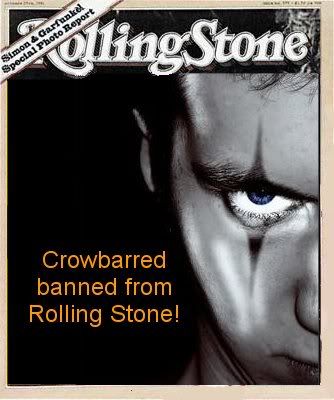








1 Comments:
For the most part I agree, Satriani and the likes would still have played guitar.
But..
Without Hendrix's preformances with the guitar, it would not have become so popular to just play the baby of all babys'
But eh who am I but a mere listener of all the greats.
Satriani, Santana, Stevie Ray...
Post a Comment
<< Home